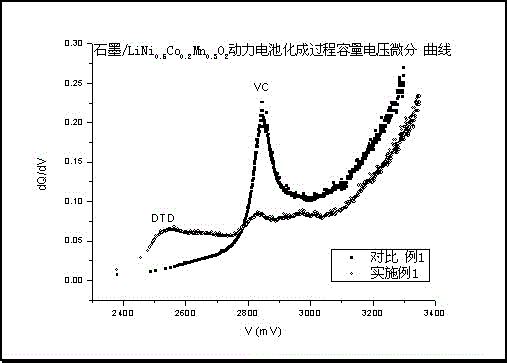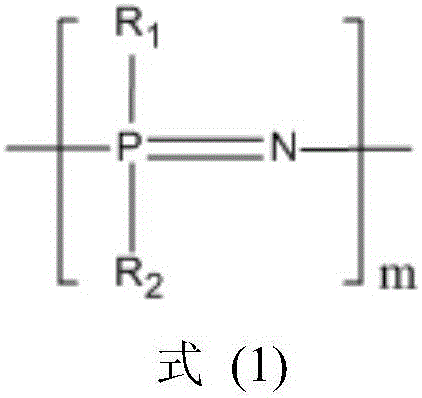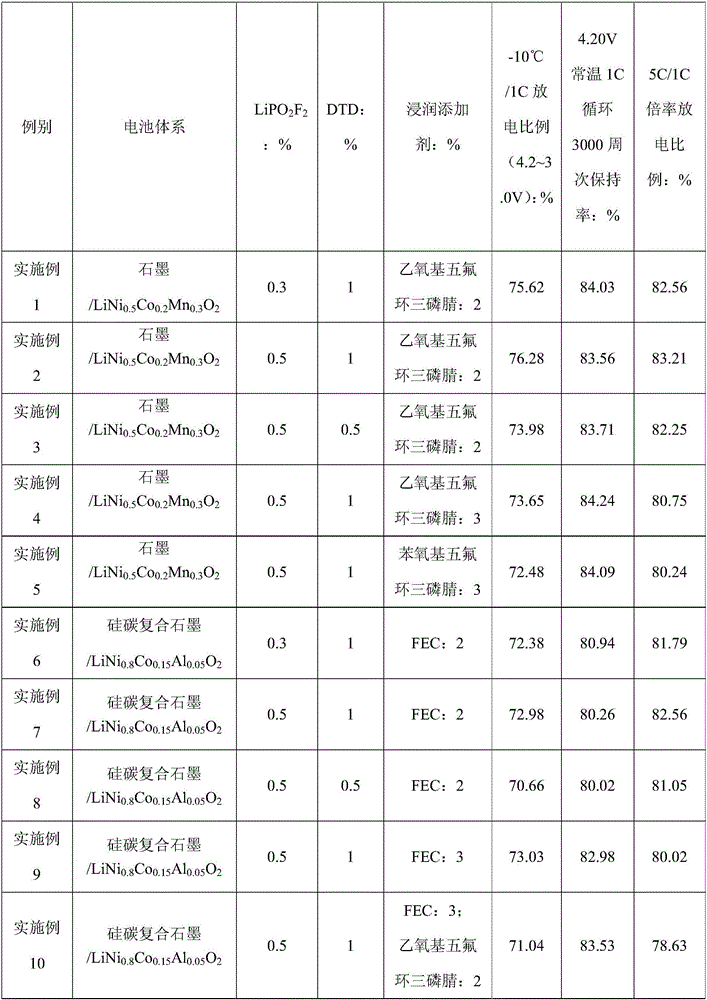High-nickel ternary lithium ion power battery electrolyte and high-nickel ternary lithium ion power battery
A power battery and electrolyte technology, applied in the field of lithium ion batteries, can solve the problems of high nickel battery safety performance to be improved, unfavorable high power output of lithium ion batteries, large impedance of methylene disulfonate, etc., so as to improve the battery Cycling performance, excellent film-forming properties on the surface of the negative electrode, and the effect of improving power safety performance
- Summary
- Abstract
- Description
- Claims
- Application Information
AI Technical Summary
Problems solved by technology
Method used
Image
Examples
Embodiment 1
[0029] Electrolyte preparation steps: In a glove box filled with argon, mix ethylene carbonate, diethyl carbonate and ethyl methyl carbonate according to the mass ratio of EC:DEC:EMC=3:2:5, and then add to the mixed solution Slowly add lithium hexafluorophosphate with a concentration of 1.0mol / L, and finally add 0.3wt% lithium difluorophosphate (LiPO 2 f 2 ), 1wt% vinyl sulfate (DTD), 2wt% ethoxylated pentafluorocyclotriphosphazene, 0.5wt% vinylene carbonate (VC), and stir to obtain the lithium-ion battery electrolyte of Example 1.
[0030] Inject the prepared lithium-ion power battery electrolyte into the fully dried 4.20V graphite / LiNi 0.5 co 0.2 mn 0.3 o 2 Power battery (energy density>200Wh / kg) or 4.20V silicon carbon composite graphite / LiNi 0.8 co 0.15 al 0.05 o 2 For power batteries (energy density > 250Wh / kg), after the battery has been put on hold at 45°C, formed in a high-temperature fixture and sealed twice, it is routinely divided.
[0031] 1) Cycling perfo...
Embodiment 2~10
[0037] Embodiment 2~10 and comparative example 1~6
[0038] In Examples 2-10 and Comparative Examples 1-6, except that the positive and negative electrode system of the battery and the functional additive composition of the electrolyte are added as shown in Table 1, the others are the same as in Example 1. Table 1 shows the battery positive and negative electrode systems, electrolyte functional additive composition and battery performance test results of Examples 1-10 and Comparative Examples 1-6:
[0039]
[0040]
[0041] Table 1
[0042] In the above Table 1, the abbreviated names of each chemical substance are as follows:
[0043] LiPO 2 f 2 (lithium difluorophosphate), DTD (ethylene sulfate), FEC (fluoroethylene carbonate).
[0044] figure 1 The comparison of the battery formation process capacity-voltage differential curves in Example 1 and Comparative Example 1 shows that: after adding DTD to the electrolyte in Example 1, it can be decomposed into a film in p...
PUM
 Login to View More
Login to View More Abstract
Description
Claims
Application Information
 Login to View More
Login to View More - R&D
- Intellectual Property
- Life Sciences
- Materials
- Tech Scout
- Unparalleled Data Quality
- Higher Quality Content
- 60% Fewer Hallucinations
Browse by: Latest US Patents, China's latest patents, Technical Efficacy Thesaurus, Application Domain, Technology Topic, Popular Technical Reports.
© 2025 PatSnap. All rights reserved.Legal|Privacy policy|Modern Slavery Act Transparency Statement|Sitemap|About US| Contact US: help@patsnap.com



